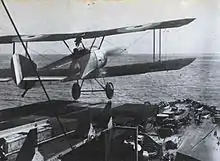.jpg.webp) Yarmouth in 1912 | |
| History | |
|---|---|
| Name | HMS Yarmouth |
| Namesake | Great Yarmouth |
| Builder | London & Glasgow Co. |
| Laid down | 27 January 1910 |
| Launched | 12 April 1911 |
| Commissioned | April 1912 |
| Fate | Sold for scrapping 2 July 1929 |
| General characteristics (as built) | |
| Class and type | Town-class light cruiser |
| Displacement | 5,275 long tons (5,360 t) |
| Length | |
| Beam | 47 ft 6 in (14.5 m) |
| Draught | 15 ft 6 in (4.72 m) (mean) |
| Installed power |
|
| Propulsion | 2 × shafts; 2 × Brown-Curtis steam turbines |
| Speed | 25 kn (46 km/h; 29 mph) |
| Range | 5,610 nautical miles (10,390 km; 6,460 mi) at 10 knots (19 km/h; 12 mph) |
| Complement | 475 |
| Armament |
|
| Armour |
|
HMS Yarmouth was a Town-class light cruiser of the Royal Navy launched on 12 April 1911 from the yards of the London & Glasgow Co. She was part of the Weymouth subgroup.

On the outbreak of the First World War, Yarmouth was on the China Station, and later in 1914, she was involved in the hunt for the German commerce raider SMS Emden. In October that year she captured two German colliers. She returned to home waters in December 1914 and was assigned to the 2nd Light Cruiser Squadron of the Grand Fleet, and in February 1915 to 3rd Light Cruiser Squadron. Whilst serving with this squadron, she took part in the Battle of Jutland on 31 May-1 June 1916.
On 28 June 1917, Royal Naval Air Service Flight Commander F. J. Rutland took off in a Sopwith Pup from a flying-off platform mounted on the roof of one of Yarmouth's gun turrets, the first such successful launch of an aircraft in history.[1] On 21 August a Pup flown by Flight Sub-Lieutenant B. A. Smart flown from Yarmouth shot down the Zeppelin L 23 near Bovbjerg.[2]
HMS Yarmouth re-commissioned at Colombo, Ceylon, in June, 1918.[3] She served as part of the 3rd Light Cruiser Squadron.[4] She re-commissioned at Colombo again on 21st March, 1919. The flag of Rear-Admiral The Hon. Edward Stafford Fitzherbert, CB, Commander-in-Chief on the Africa Station, was flown in Yarmouth temporarily. In 1919, she stopped at Tristan da Cunha, the first ship in ten years, to inform the islanders of the outcome of World War I.[5] After the war, she joined the 7th Light Cruiser Squadron on the South America Station.[6][7]
Yarmouth was sold for scrapping on 2 July 1929 to the Alloa South Breaking Company, of Rosyth.
Notes
- ↑ Sturtivant, Ray, British Naval Aviation: The Fleet Air Arm, 1917-1990, Annapolis, Maryland: Naval Institute Press, 1990, ISBN 0-87021-026-2, p. 215.
- ↑ Robinson, D. The Zeppelin in Combat, Henley-on-Thames, UK: Foulis, 1971 (3rd ed.). ISBN 0 85429 130 X, p.241-2
- ↑ "LIST OF SHIPS AND VESSELS OF THE ROYAL NAVY, WITH THEIR OFFICERS AND PRESENT STATIONS". THE NAVY LIST. London, England, UK: His Majesty's Stationery Office. 1 January 1919. p. 945a.
- ↑ "I.-The Grand Fleet—continued. Third Light Cruiser Squadron.". The Navy List. London, England, UK: His Majesty's Stationery Office. 1 July 1918. p. 11.
- ↑ "Tristan da Cunha Isolation & Hardship 1853–1942". Tristan da Cunha Government & Tristan da Cunha Association. Retrieved 1 January 2019.
- ↑ "XIV.— OTHER FOREIGN STATIONS. SOUTH AMERICA. Light Cruisers". The Navy List. London, England, UK: His Majesty's Stationery Office. 1 September 1919. p. 714.
- ↑ "VIII— OTHER FOREIGN STATIONS. SOUTH AMERICA. Seventh Light Cruiser Squadron.". The Navy List. London, England, UK: His Majesty's Stationery Office. 1 January 1921. p. 714.
References
- Colledge, J. J.; Warlow, Ben (2006) [1969]. Ships of the Royal Navy: The Complete Record of all Fighting Ships of the Royal Navy (Rev. ed.). London: Chatham Publishing. ISBN 978-1-86176-281-8.
- Jane's Fighting Ships of World War One (1919), Jane's Publishing Company
- Ships of the Weymouth group